
Despite a night of wind and rain in Middlemarch, we got up refreshed. Jack's Stone Cottage where we were staying comes equipped with cooking utensils and breakfast supplies; we enjoyed a breakfast of eggs, toast and jam; our only complaint was we had to use "spread" instead of good New Zealand butter on our toast.
It was a bit nippy but not all that cold. We put on an extra layer thinking we would shed it shortly as the sun warmed things up. But as soon as we started riding we weren't so sure. The day was not the pleasant sunny summer day we had imagined the evening before. It was windy and raw. The wind was out of the South, a surprise to us but we weren't complaining. We were starting out on the trail from the "wrong" end, and the wind was at our backs!
 |
Ahead of us we could see the well-known "Taieri Pet" starting to form, a "lenticular billow cloud" formation known to bring raw, windy weather. It forms over the Rock and Pillar Range that borders the Strath Taieri Valley we were riding up, and has rapidly circulating winds within the cloud (or clouds if multiple clouds are stacked). The clouds don't normally touch down — good for us — but our strong winds gave us a mild taste of what was going on up there.
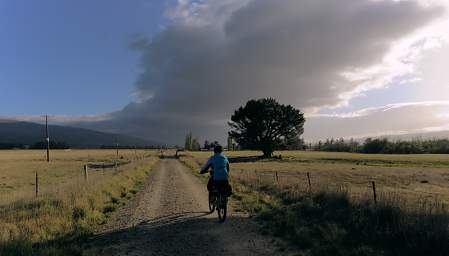 |
| Clouds Building |
We passed pastures full of sheep and occasional irrigated fields.
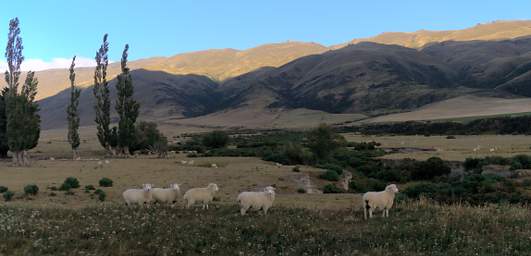 |
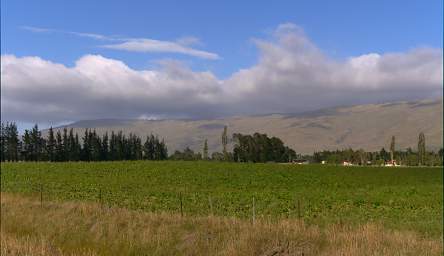 |
| Sheep | Sheep Feed |
As we looked to the Rock and Pillar Range on our left we could see the large schist blocks, called "Tor"s, on its skyline that give the range its name.
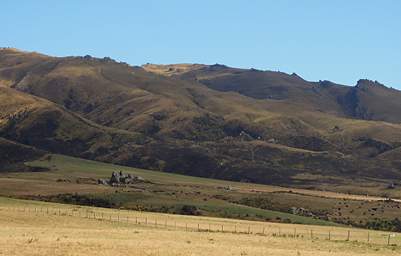 |
| Rock And Pillar Range
|
Every ten km or so along the trail you come to a "Ganger's Shed." Gangers were maintenance workers responsible for keeping a section of track in usable condition for the railroad. The sheds were shelters from the often brutal weather, a haven in an otherwise hostile (at times) landscape. Now, the sheds are still a haven in bad weather for bicyclists and hikers on the rail trail, but they also provide useful information about interesting features at that point on the trail going in each direction from the shed. The first one we came to was the Rock and Pillar Ganger's Shed, and it explained the Taieri Pet and the geology of the Rock and Pillar Range.
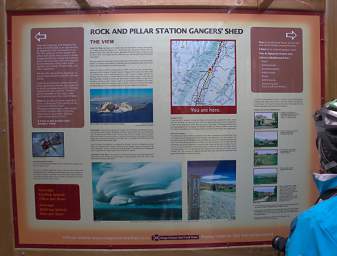 |
| Rock And Pillar Gangers Shed Interpretive Sign |
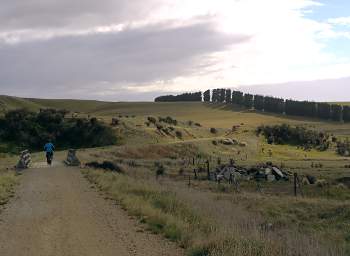 |
The Rock and Pillar Range has numerous places to hike and explore, and one can access it from the Rail Trail. We did not have time to take any walks up there, but it's something to consider if you're in the area for a longer period of time. The ganger's shed information displays had maps of the immediate area showing not only the rail trail but the surrounding hiking trails. The Strath Taieri Ganger's Shed talked about the common flora and fauna, and about the Hyde train wreck which occurred just up the way in 1943.
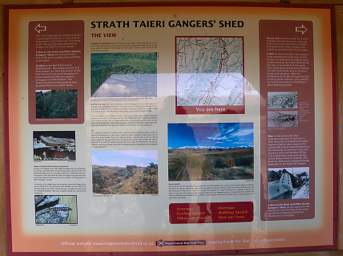 |
| Strath Taieri Gangers Shed Interpretive Sign |
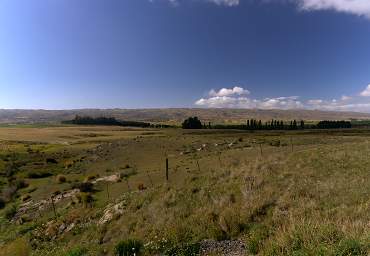 |
| Looking Southeast |
 |
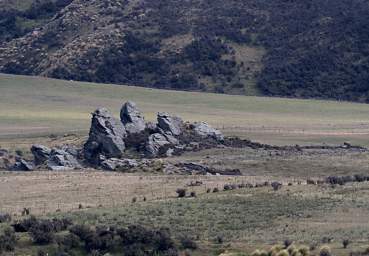 |
| Rock and Pillar Range | Close-up of Schist Outcrop |
As in most of New Zealand, we didn't see much endimic wildlife. But we did come across Paradise Shelducks, a relatively abundant species.
 |
| Paradise Shelducks (Tadorna variegata) |
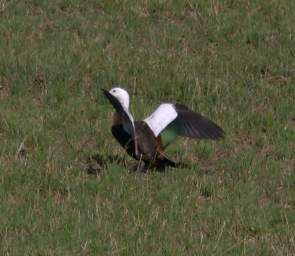 |
| Paradise Shelduck (F) (Tadorna variegata) |
Being a former railroad track, the rail trail has substantial bridges and trestles crossing the numerous gulleys where creeks come down from the surrounding mountains. They are a treat to a model railroad fan, as well as giving you a safe and secure crossing. The first one we crossed was pretty simple, but some of the ones later on were pretty cool.
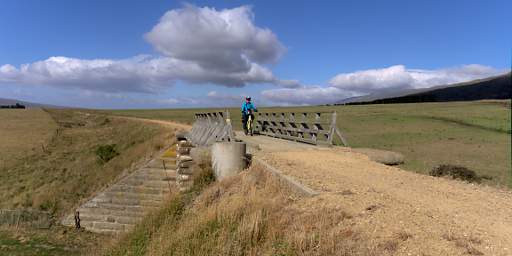 |
| Dona on a Bridge |
Despite the raw weather, we were having a good time. Dona had on most of the cycling clothes she had brought with her, from her Icebreaker sweater to a windbreaker / rain jacket to special riding gloves. When I asked her about them she said "I've got special riding pants too, with a padded butt!" She was concerned about having trouble riding a long ways over five days, but she did really well. I was a less bundled up and was greatful to have my Icebreaker tee on under my shirt and vest. Icebreakers are awesome — wool you can wear next to your skin, comfy in hot weather or cold, rain or shine.
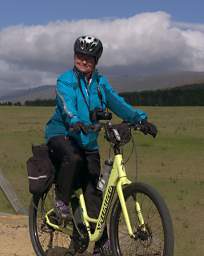 |
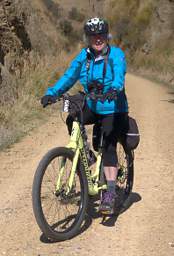 |
| Dona bundled up | |
 |
 |
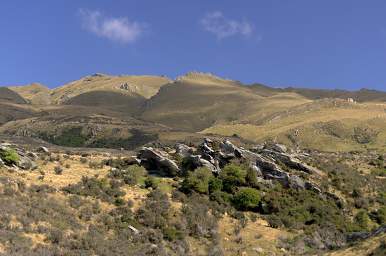 |
| |
|
| Rock And Pillar Range | |
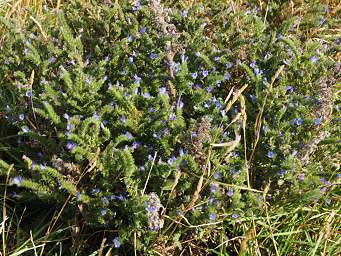 |
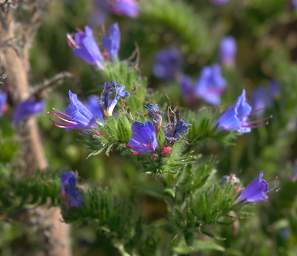 |
| Flower Xxx Blue
|
Flower Xxx Blue |
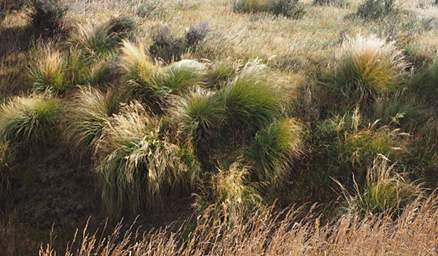 |
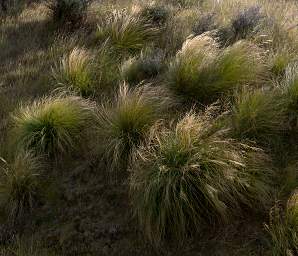 |
|
| Tussock Grass | |
The gangers' sheds had information about flora and fauna as well as historical events along the trail. One of the things we learned about was divaricating plants. About 10% of New Zealand's plants are divaricating. Divaricating plants have small leaves and the twigs and branches are tightly intertwined, criss-crossing and forming a difficult to penetrate protective shield of sorts. While many of these plants are shrubs, some are trees — they are divaricating when small, and gradually straighten as they get taller and mature.
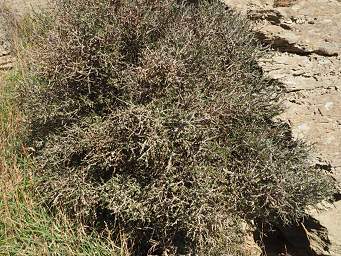 |
| Divaricating Shrub Xxx
|
Another thing we learned about, but did not see, were some of the native fish. While New Zealand is known today for some excellent trout fishing, both brown and rainbow trout are introduced species, brought in during the last half of the 19th century. Chinook Salmon have also been successfully introduced. Most of New Zealand's native freshwater fish are from the Galaxiidae family. Like most other introductions, exotic species are generally not good for the natives. Introduced salmonids (trout and salmon) compete with the native galaxids for food; and have caused some local extinctions.
 |
| The Trail, Rock and Pillar Range on the Left
|
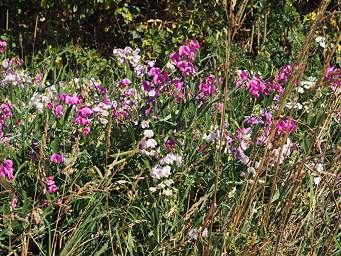 |
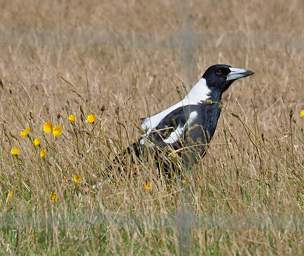 |
| Flower Xxx Violet White
|
Australian Magpie (Gymnorhina Tibicen)
|
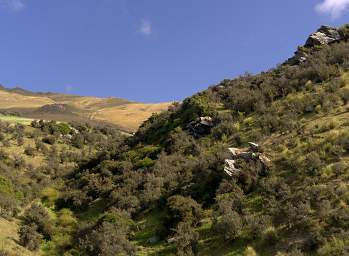 |
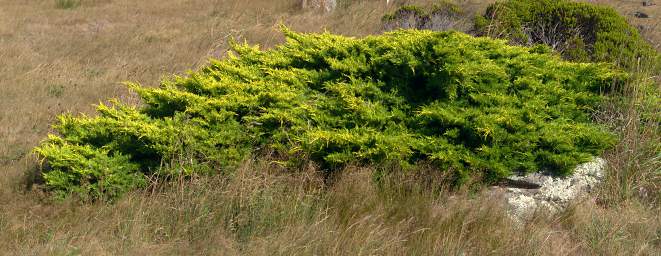 |
| Groundcovering Shrub |
We stopped at the memorial for the Hyde Train Wreck. It happened in winter of 1943 when the Cromwell-Dunedin express derailed while rounding a curve. The locomotive and all seven cars derailed. Some cars telescoped together and others were completely destroyed. The crash exploded the boiler which put out the engine fire; otherwise all of the passenger cars might have caught fire. 21 passengers were killed and 47 injured. The investigation into the accident concluded the train had entered the curve at 112 km/hr (70 mph); the speed limit was 48 km/hr. The engineer / driver was found guilty of manslaughter; some have argued he was fatigued from working long hours and was a scapegoat for the Railways Department. The accident is the second-worst railway disaster in New Zealand history, and the only wreck over the lifetime of the train.
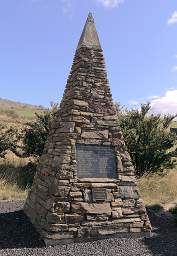 |
| Hyde Train Wreck Memorial |
We were passing through sheep country, and in many places the sides of the rail trail were fenced. We encountered different designs of stiles for allowing easy access across the fence.
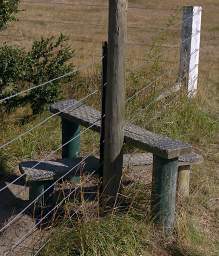 |
| Stile |
 |
| Trestle |
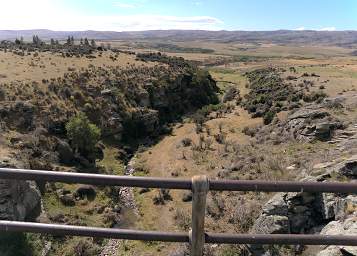 |
 |
| Bridge |
There were ripe berries of some kind growing along the trail; I think they were some kind of elderberry. The Scrub Burn Ganger's Shed interpretive sign says that fruit trees and shrubs are common along the trail, a result of "cores and pips" tossed from the train.
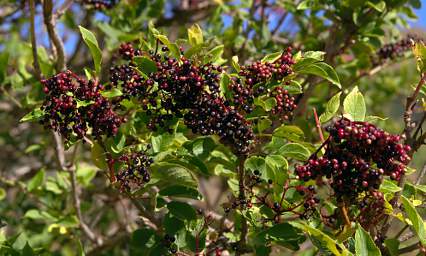 |
| Berries |
 |
| Scrub Burn Ganger's Shed Interpretive Sign |
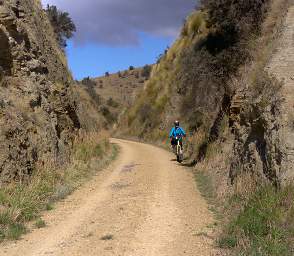 |
In due time we came to Hyde, a former mining town but now a tiny almost-village. We had planned to have a bite to eat and buy some supplies at the Hyde Cafe in the Otago Central Hotel building, but it was closed because the girl who was supposed to be running it was sick. This was not particularly good news, as it is the only source for food in the area and we didn't have much for snacks for the next leg of our journey. We would just have to fill up at breakfast and make do; we still had a few things we hadn't eaten at lunch.
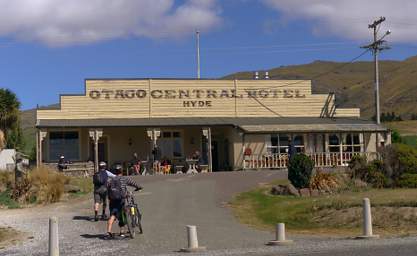 |
| Hyde Otago Central Hotel |
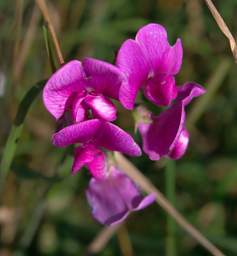 |
| Flower Xxx Violet |
Our accomodations for the night were at Peter's Farm. It was some distance from Hyde, and we didn't have a map to get there. However, Peter had left us a car with directions so we left our bikes in the bike rack at the hotel, hopped in the car and motored to the farm. We had arrived with lots of time and could have ridden out to it but we stuck to the plan...
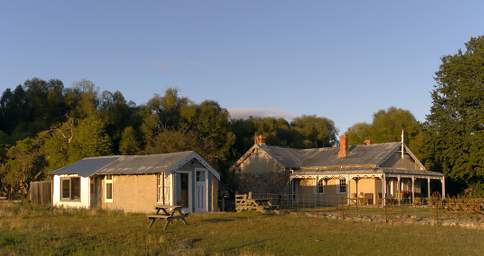 |
| Peters Farm |
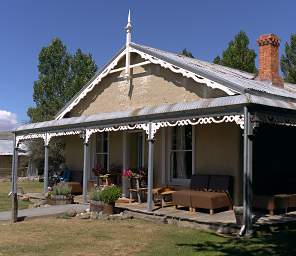 |
 |
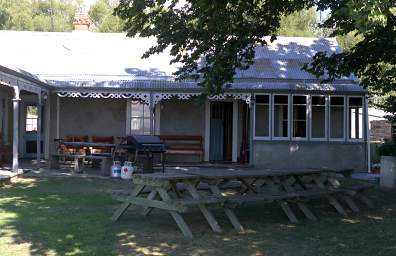 |
| Tired Traveler |
When we arrived we were the only guests at the farm. Peter showed us around the house and gave us our choice of rooms. The house is pretty interesting, with hand-painted wallpaper and lots of old "stuff."
 |
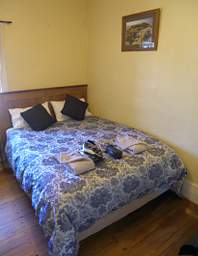 |
| Room | |
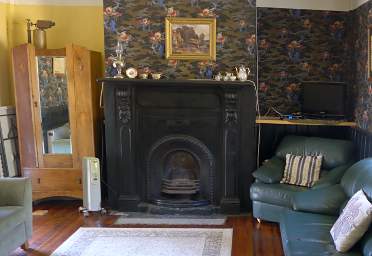 |
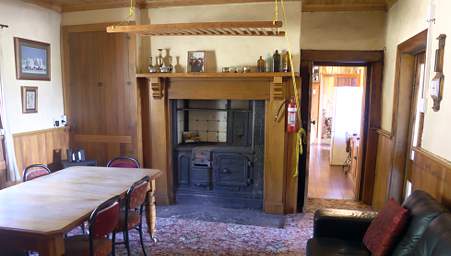 |
| Peters Farm | |
Standing in a corner was a huge old bellows, probably from a blacksmith operation. In the kitchen there was a great seasonal food storage cupboard which was basically a cupboard installed in a hole through an outside wall on the north side. A great place for items like butter which needed to be cool but not refrigerated. The outside porch with a long bench table for meals was open on one end. Peter referred to the wood in the table as "Oregon Wood"; it was Douglas Fir, introduced to New Zealand from the Pacific Northwest in the United States.
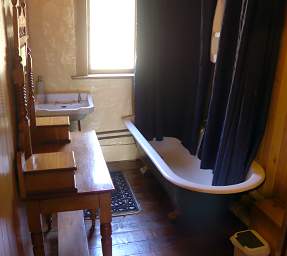 |
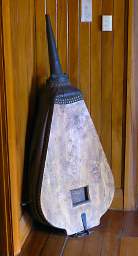 |
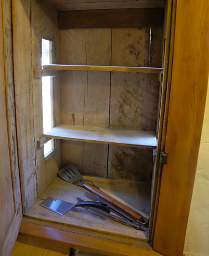 |
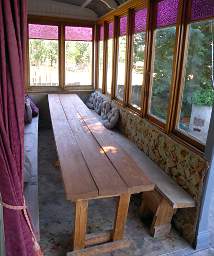 |
| Bath | Bellows | Food Storage | Porch |
The wallpaper in the house was hand-painted, something I have trouble comprehending. I wish I had asked Peter for more information about how it was done, as it looks too even / exact to be hand painted.
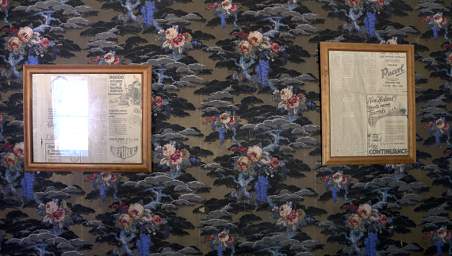 |
| Hand Painted Wallpaper |
I found the old newspaper articles hanging on the walls interesting. Apparently there was an election in which one party wanted to enact prohibition, perhaps following the U.S. example. The ad claimed it would be devastating to the newly blooming tourist industry, it hadn't solved unemployment problems in the U.S., and the prime minister is quoted as saying "We are five times better off than the United States of America, which claims to be the most prosperous country in the world." They are still probably five times better off than many Americans, judging by their better health care, lack of stress, and general good cheer. In addition, unsuprisingly, there were also ads for close-to-guaranteed get rich schemes from the equivalent of Wall St.
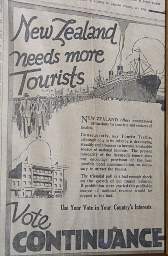 |
 |
 |
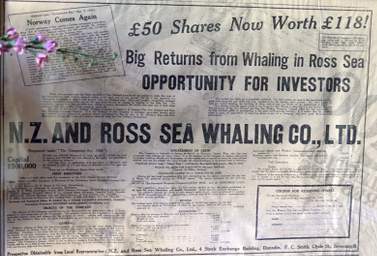 |
| Old Papers | |||
I inspected the "cottage," a converted three-sided shed outside the main building and decided it looked like more fun, so we moved out of the main building and into the cottage. Its walls were of bricks made from mud and tussock grass and dried in the sun; the posts once supporting the open side were about a foot inside the room. It was very comfortable and quiet, a great place to go to sleep and wake up to the birds singing nearby. When we woke up in the morning there was a light frost on the grass.
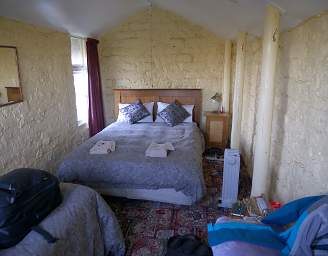 |
 |
| Cottage | Handmade Bricks |
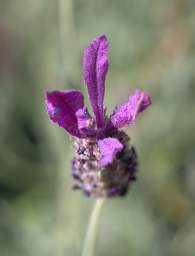 |
| Flower Xxx Purple |
Towards the end of the afternoon Peter's brother drove a few hundred sheep up the lane to a different pasture. He followed in a truck while his dog did most of the work. It's always fun to watch a dog that knows what it's doing working animals.
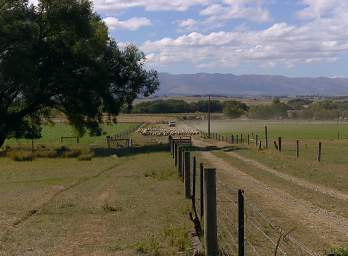 |
 |
| Moving Sheep | |
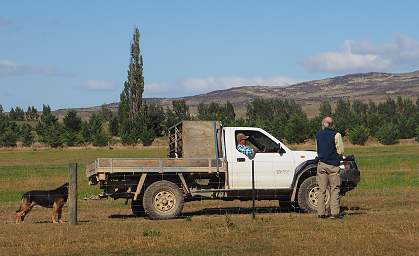 |
| Gary talking Sheep with Peter's Brother
|
Peter said we could use the car to wander around, so we wandered higher up the side of the Rock and Pillar Range and came to the cemetary. It was enclosed by a great rock wall, built carefully long ago without any mortar. You can do that when you have great angular rocks to work with!
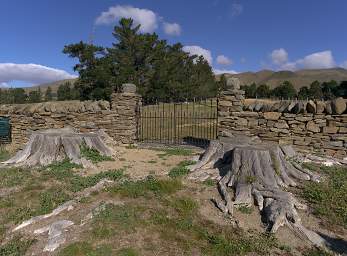 |
 |
| Cemetary entrance | Inside the Cemetary |
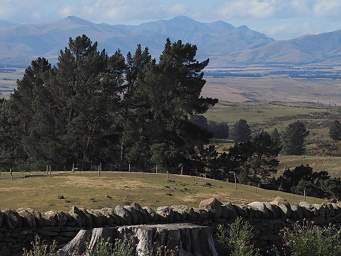 |
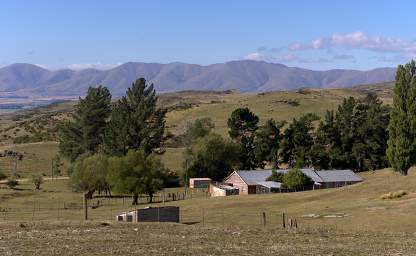 |
| |
|
| View from Cemetary | |
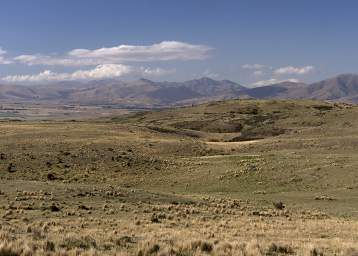 |
Peter had a little dog that he'd taught to "herd" a basketball. It was pretty good at it.
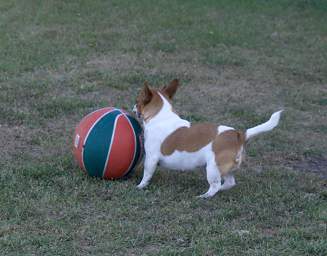 |
| Herding Dog |
One other guest arrived before dinner, a former U.N. Peacekeeper. He was riding the trail both ways and doing it twice as fast as we were — three days each way. It was interesting learning about the work he had done in the disintegrating former Yugoslavia and other parts of the world.
We had a feast for dinner — BBQ steaks and sausage, potatoes, salad and a dessert of ice cream, kiwis and cake. I don't know what kind of cake and ice-cream it was, but it sure was good! We were stuffed; no, we were over-stuffed.
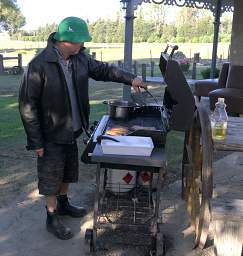 |
 |
| BBQ | Dona and U.N. Peace Keeper |
After dinner we snuggled into bed about as contented as is possible. The next day we rode on from Hyde to Ranfurly.